
Sea buckthorn: planting, growing and care
Contents
Sea buckthorn in a nutshell
- Sea buckthorn is a bush with thorns well known in our native flora
- Undemanding, it can grow in very poor soil.
- Sea buckthorn produces fruits very rich in vitamin C, used to make syrup, juice or jam.
- Useful and ornamental, it is equally suitable for an informal or defensive hedge as for a solitary specimen or a mixed border.
A word from our expert
A bush well known within our native flora, sea buckthorn is surprisingly and unfairly shunned in our gardens. Yet it is one of the hardiest and most accommodating bushes around because it is, above all, a pioneer species. It grows on poor, sandy or calcareous soils and its ability to fix nitrogen in the soil is an asset: it helps to “prepare the ground” so that other species can establish in turn.
Very much at home in an untrimmed informal hedge and defensive thanks to its many thorns, it can also be used as a specimen or within a mixed bush border as it is highly decorative with its silvery foliage, twisted habit and numerous bright orange berries in autumn. Its tasty, vitamin-rich fruits can also earn it a place of choice in a small-fruit orchard.
Its ability to stabilise banks and unstable soils, as well as the fact it can provide shelter and food for many animals (bees, birds and small mammals) make it one of the species most replanted in coastal natural areas in France and Belgium.

Hippophae rhamnoides-‘Friesdorfer Orange’
Botany and description
Botanical data
- Latin name Hippophae rhamnoides
- Family Elaeagnaceae
- Common name sea buckthorn, false buckthorn, coastal buckthorn, thorny willow, Siberian olive, griset, marant thorn, Siberian pineapple
- Flowering March-April
- Height 4 m
- Exposure sun
- Soil type ordinary ground, even poor, well drained
- Hardiness -30°C
Sea buckthorn or Hippophae rhamnoides is native to Europe and Asia and grows wild in mountainous regions or along coasts. This species belongs to the family Elaeagnaceae and is the only representative of the genus Hippophae. It was formerly known as Eleagnus rhamnoides. Used for millennia for the flavour of its fruits, for making brooms and for its cosmetic and medicinal properties, sea buckthorn has many vernacular names: false buckthorn, coastal buckthorn, thorny willow, Siberian olive, griset, marant thorn or even Siberian pineapple.
This is a bush with stiff, vigorous thorns and a rather open crown, ideal for a defensive hedge. It is also highly ornamental thanks to its somewhat twisted habit, upright very ramified stems and foliage grey above, punctate with a silvery-white to coppery underside. Leaves are narrow, 2 to 8 cm long, alternate and lanceolate. Shoots are covered with silvery hairs and the terminal shoot ends in a thorn.
Sea buckthorn is a dioecious bush, which means there are male and female plants. You therefore need to plant both if you intend to harvest fruit. Fortunately, self-fertile varieties exist such as ‘Friesdorfer Orange‘. Flowers appear before the leaves between March and April. Although inconspicuous, they are much appreciated by bees. Male and female flowers differ: both form short, yellowish clusters, but male flowers are sessile and short while female flowers are tubular. You can distinguish male and female plants in winter by their buds: males have conical, erect buds while females have small, rounded buds.
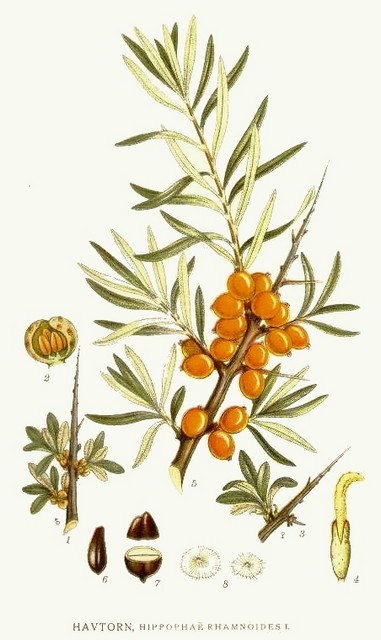
Hippophae rhamnoides – botanical illustration
Female flowers then produce orange fruits, drupes about 8 mm in diameter, from September to December. Fruits remain throughout winter and are a favourite of birds and pheasants that disperse the seeds locally. The fruits have been used for centuries and are an important source of vitamin C, but also contain vitamins A, B, E, F and P as well as mineral salts. They are still consumed today to boost immunity, fight fatigue or to protect the skin in cosmetics.
It only grows in full sun, but has very rapid growth, nearly one metre per year, and produces many suckers, especially on sandy soils, which makes it perfect for greening a rather neglected spot quickly. Extremely hardy, it also resists drought, wind, sea spray, air pollution and soil salinity. However, its longevity rarely exceeds eighty years.
Sea buckthorn is also a pioneer bush in nature. It favours poor, sandy or calcareous soils on the coast, at the edges of mountain torrents… but in any case well drained. It stabilises banks and has the ability to fix atmospheric nitrogen in the soil. In truth, this trait is harmful in the long term, because it enriches the soil, which favours the arrival of other species of trees or bushes that eventually shade it and prevent it from growing.
Please note : do not confuse sea buckthorn with the arbutus or Arbutus unedo, an evergreen bush of the family Ericaceae growing all around the Mediterranean. These two bushes therefore have absolutely nothing in common apart from a few letters in their names.
Our favourite varieties
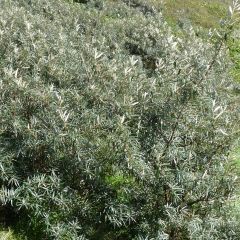
Hippophae rhamnoides Pollmix
- Flowering time May
- Height at maturity 4 m

Hippophae rhamnoides Leikora
- Flowering time May
- Height at maturity 4 m

Hippophae rhamnoides Friesdorfer Orange
- Flowering time May
- Height at maturity 3 m
Discover other Hippophae
View all →Available in 0 sizes
Available in 1 sizes
Available in 1 sizes
Available in 3 sizes
Available in 2 sizes
Available in 1 sizes
Available in 1 sizes
Available in 1 sizes
Available in 1 sizes
Available in 1 sizes
Planting sea buckthorn
Where to plant?
Sea buckthorn is indifferent to soil type and pH. You can plant it in all ordinary soils, even poor, sandy, calcareous, clayey… Although favouring well-drained soil, this bush does not fear moisture, nor drought for that matter. It grows faster in fertile soil but copes with poor soils because it enriches them itself by fixing atmospheric nitrogen (like leguminous plants or alder). It is therefore a top choice for revegetating disturbed areas: garden of a newly built house, for example.
Give it a position in full sun; it will set fruit much better there. It tolerates wind and sea spray particularly well.
Moreover, thanks to its suckering qualities, sea buckthorn is ideal for stabilising unstable soils, riverbanks, embankments…
When to plant?
Plant preferably in early autumn from September to October. Otherwise, planting in spring before leaf emergence is possible between March and early April.
How to plant?
- Immerse pot in a bucket of water for one hour.
- Dig a hole twice the volume of your bush’s rootball.
- Loosen soil well and add a handful of compost or sand to the bottom of the hole to improve drainage.
- Remove your bush from its pot and begin to gently break up the rootball to free the roots. Check at this stage that the roots are neither damaged nor rotten. If so, cut them off.
- Place the rootball at the bottom of the hole, spreading the roots well, and backfill with the excavated soil.
- Firm soil and apply mulch, then give a generous watering with water to eliminate air pockets between the roots and the soil.
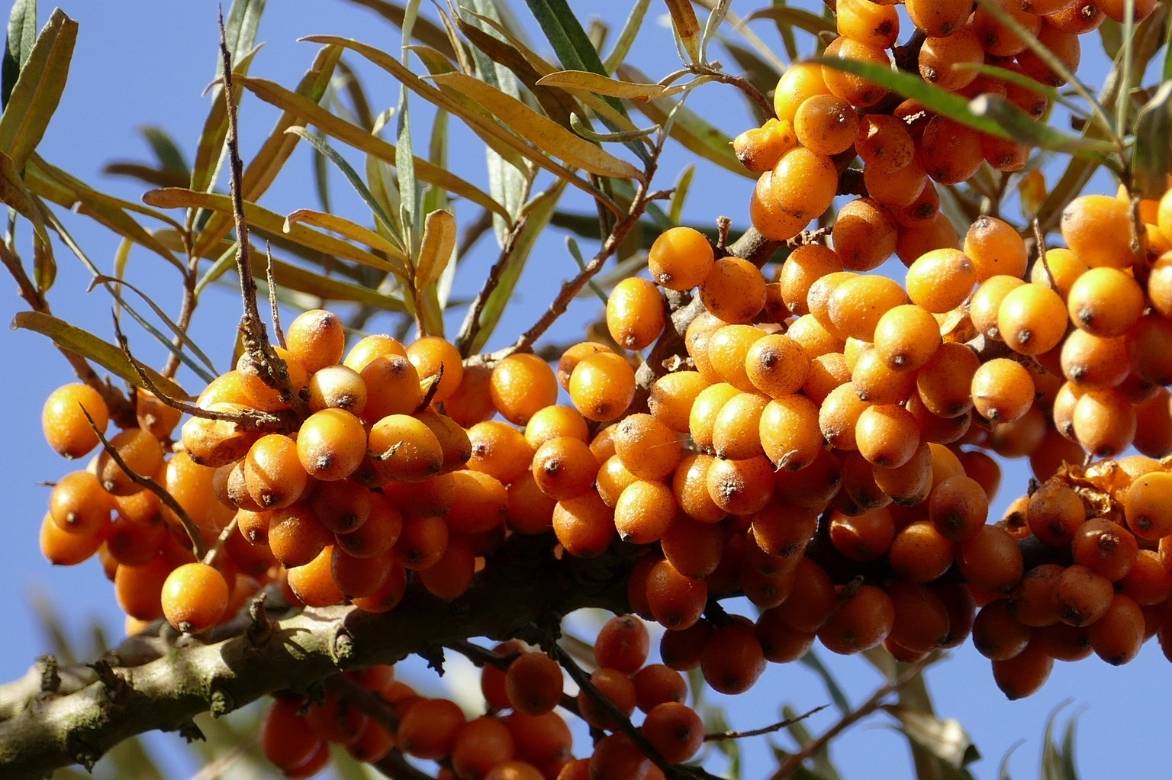
Propagation of sea buckthorn
Although sowing is theoretically possible, birds in nature help disperse seeds almost everywhere, so result is often unpredictable, particularly as regards sex of plants obtained this way.
Propagation by cuttings is much simpler and less hit-and-miss. You can propagate young herbaceous or semi-ripe shoots directly in sand (technique adopted in management of natural habitats to recolonise sea buckthorn stands more rapidly on the coast) or simply in water.
please note: cuttings in water are extremely simple and quick to carry out. Simply place a vase filled with water in bright light into which you have placed what you wish to propagate. Change water as soon as it starts to smell to prevent algal proliferation and pot your cutting as soon as first roots appear. If you wait too long, roots formed this way will be accustomed to this “liquid medium” and will struggle to adapt to soil afterwards.
Pruning and care of sea buckthorn
Care
Care is limited to monitoring your bush during dry spells in its first year: water if in doubt. Otherwise, sea buckthorn grows very well without any intervention.
Diseases, pests and harmful organisms
Nothing to report!
A fungus called Verticillium dahliae can cause verticillium wilt, which can make bushes die back in less than two years. This disease is, however, extremely rare on sea buckthorn in our regions and varieties offered commercially are resistant.
Leaves of your sea buckthorn may become distorted and show small bumps. This is a gall produced by a tiny mite named Aceria hippophaena. It is not a disease and is by no means dangerous for the bush.
→ Learn more about diseases and pests of sea buckthorn in our advice sheet.
Pruning
Pruning is unnecessary to encourage fruiting of your sea buckthorn. You can remove lower branches in spring that have died through lack of sunlight and remove suckers if they become too invasive.
Companion planting in the garden
Unusual small fruiting plants
If you have a small spot with poor soil in full sun and you like fruit, I may have something for you… First plant a handsome self-fertile sea buckthorn such as ‘Friesdorfer Orange’, and pair it with a little cousin from Japan, the Japanese Goumi. This rather unknown bush also appreciates poor soils and full sun and will reward you with small red berries all summer. A self-fertile variety of fig will complete the picture: ‘Brown Turkey’ is very hardy and fruits twice a year. At the base of these, try dwarf pomegranates. They are indifferent to soil type, withstand drought and tolerate down to -15°C.

One example of a delicious planting: Sea buckthorn ‘Friesdorfer Orange’, Elaeagnus multiflora (Goumi), Fig ‘Brown Turkey’ and Punica granatum ‘Nana’
A grey-silver bush bed for full sun
Sea buckthorn ‘Pollmix’ has magnificent grey-silver foliage whose orange berries contrast beautifully in autumn. The silver caragana is little known, yet very hardy. It is striking with its attractive silvery foliage highlighted by mauve flowers in summer. In addition, it has the same qualities as sea buckthorn: it enriches soil and stabilises it by suckering. Coyote willow is one of the rare willows able to grow in dry, poor soil. Its slender stems with grey-blue foliage give a light, luminous aspect. If you add a spring tamarisk, the small bed will be in bloom from May with a shower of little pink flowers. A few Afghan sages will complete the picture as flowering groundcover.
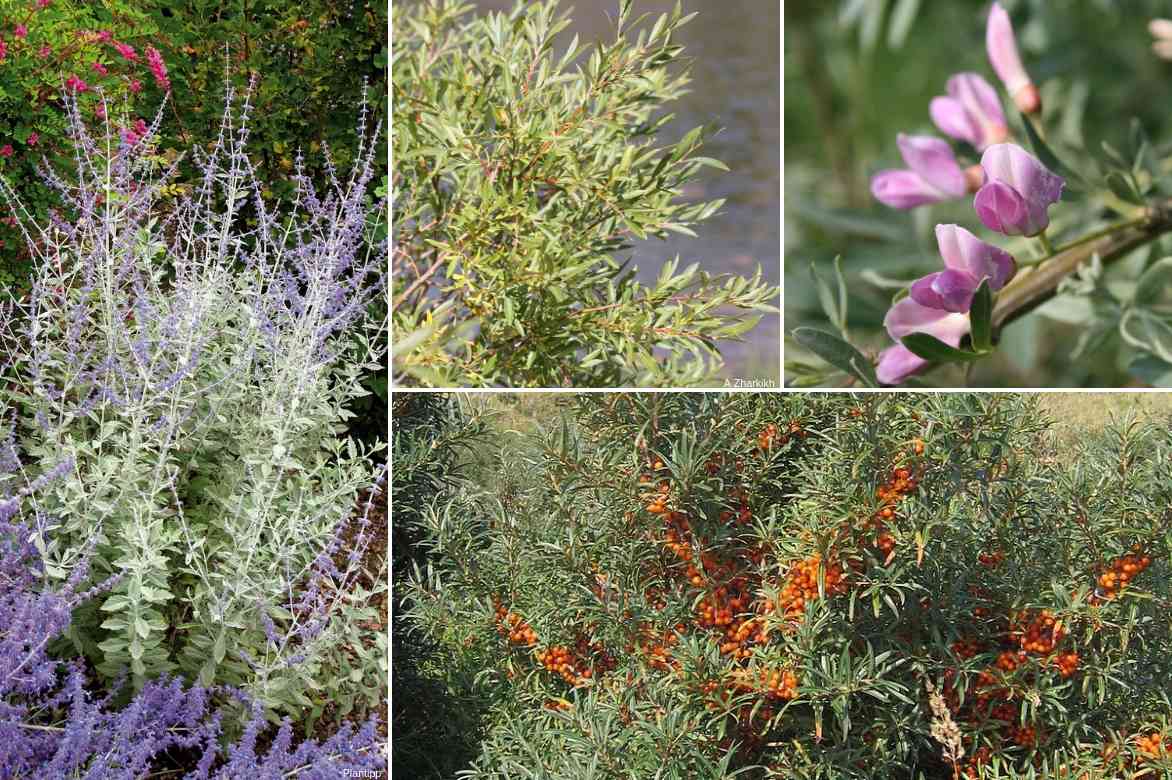
One example of a full-sun bed: Perovskia ‘Silvery Blue’, Salix exigua, Halimodendron halodendron, and of course sea buckthorn Hippophae rhamnoides ‘Pollmix’
A defensive hedge with high value for biodiversity
The idea is to create a loose hedge whose bushes will provide shelter for wildlife thanks to their thorns, melliferous and nectariferous flowers, and late-season fruit that will delight the palate of birds and small mammals. A female sea buckthorn ‘Leikora’ will be very well accompanied by other trouble-free bushes with the qualities listed above: Berberis julianae, Pyracantha, hawthorn, blackthorn, Japanese quince, …

One example of a defensive hedge: Sea buckthorn ‘Leikora’, Crataegus monogyna, Berberis julianae and Chaenomeles superba ‘Jet Trail’
Recipe using sea buckthorn berries
Sea buckthorn berry jam
please note : sea buckthorn berries are picked between October and November with gloves.
- Pre-cook sea buckthorn berries for a few minutes in a pan with a little water to soften them slightly
- Pass them through a sieve or blend them to remove tough bits
- Weigh remaining pulp and add an equal weight of sugar
- Heat in a pan (copper pans are best!) and bring to the boil
- During cooking, remember to stir with a wooden spoon
- Occasionally drop a little onto a cold saucer; if jam sets, stop heating
- Pour into jars and seal
- Turn jars upside down to sterilise and leave to cool
Pointless anecdotes
-
The name Hippophae comes from the Greek hippos = horse and phaos = light. In Antiquity, sea buckthorn berries were given to horses to give them a glossy coat and mane and also to treat eye problems. Sea buckthorn leaves were, moreover, a delicacy for Bucephalus, horse of Alexander the Great.
- Even today, sea buckthorn berries are included in poultry feed in Asia and Russia, which deepens egg yolk colour… they are also fed to farmed rainbow trout to make them more colourful.
- In the past, thorny branches of sea buckthorn were used to make brooms.
- Sea buckthorn berries were mainly consumed in Asia and Russia: as jam, as compote, in sauces, as seasoning or to flavour certain spirits. But some French farmers have recently taken up sea buckthorn cultivation in response to a decline in the fruit market.
Useful resources
Discover our selection of sea buckthorn.
Find out more in our care sheet: Sea buckthorn, an edible fruit with many benefits
Frequently asked questions
-
Do I need to plant more than one sea buckthorn to get fruit?
Sea buckthorn is a dioecious plant. This means there are male and female plants. To produce fruit, female sea buckthorn plants need a male sea buckthorn nearby for pollination. Fortunately, self-fertile varieties such as 'Fierdsdorfer' exist and spare you having to plant male and female plants.
-
I have a small, partially shaded spot — can I try planting a sea buckthorn there?
By definition, sea buckthorn is a pioneer species and therefore prefers full sun. However, your sea buckthorn will survive in partial shade, but it will be more spindly and produce very little fruit. In fact, most plants with silvery foliage are sun-loving plants: this is an adaptation to full sun and dry soils.
- Subscribe!
- Contents
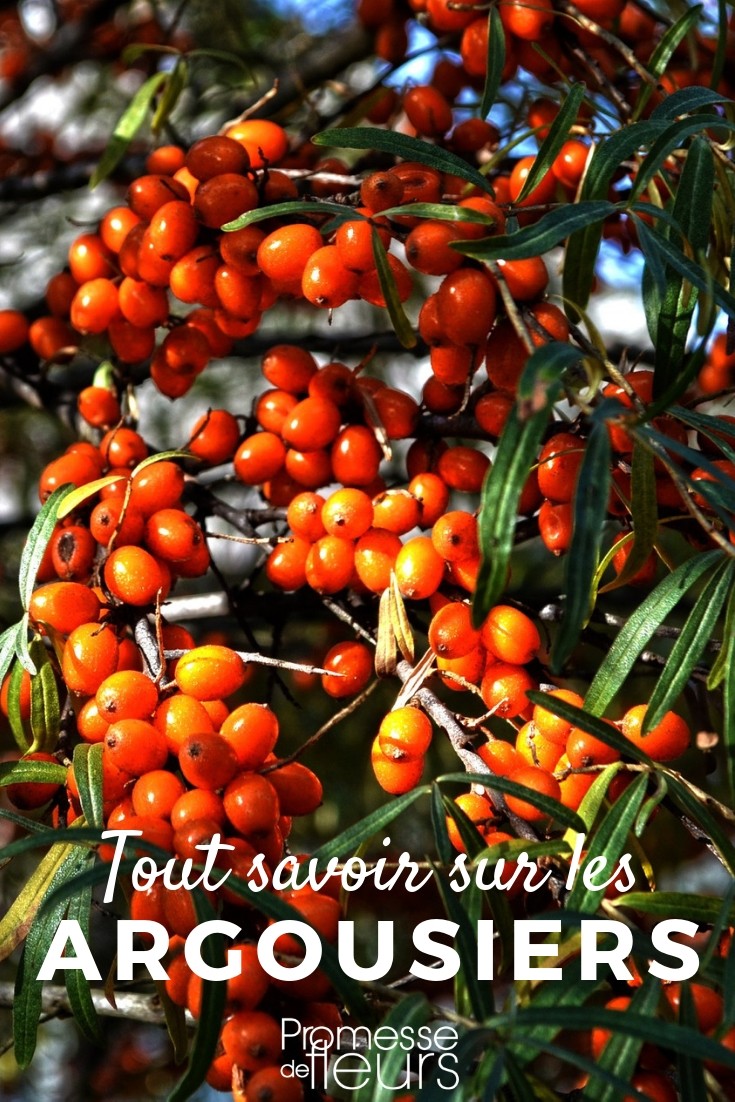































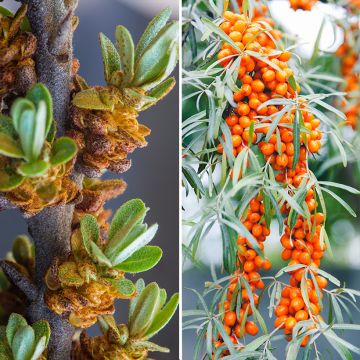
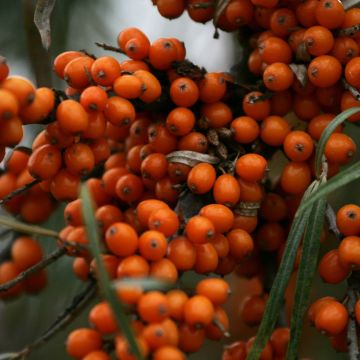

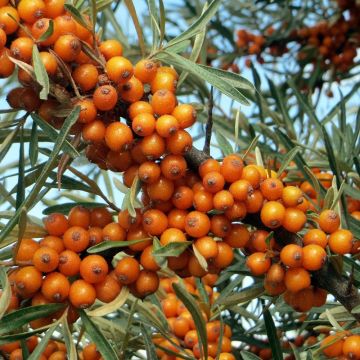

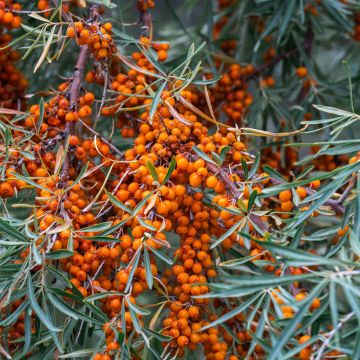
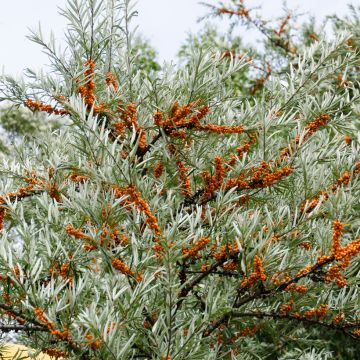
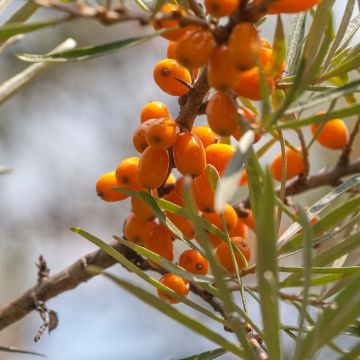
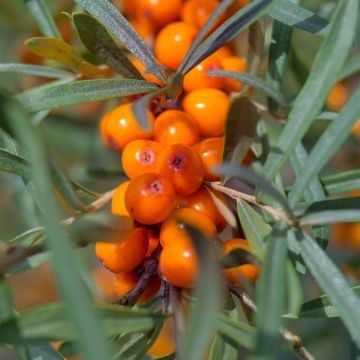
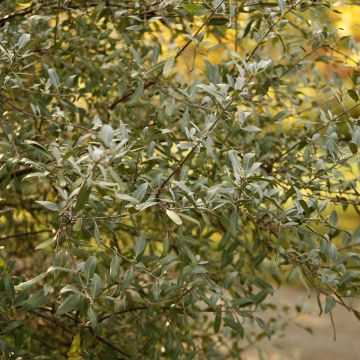
Comments